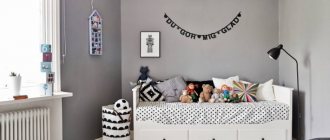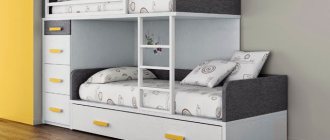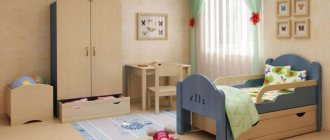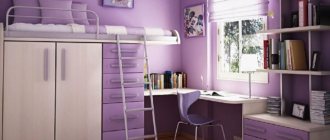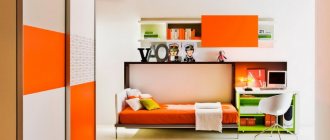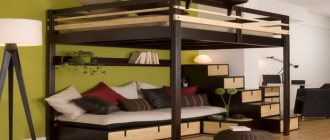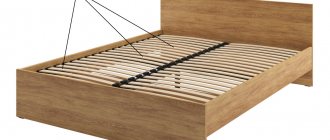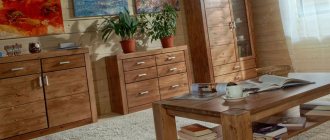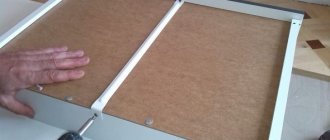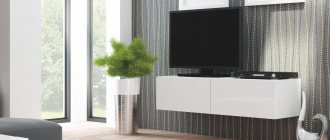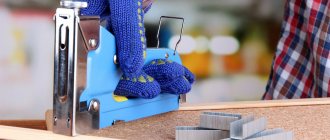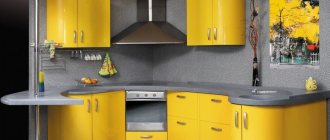In today's difficult economic conditions, when prices on the real estate market are constantly rising and the purchasing power of the population is falling, the issue of acquiring spacious housing is very pressing. This is especially true for large families with two or more children. Unfortunately, only a small part of the population can acquire large living space.
Therefore, furniture and interior designers are offering more and more effective solutions for saving space in rooms, one of which is bunk furniture, including beds.
Features of bunk beds
Modern bunk beds have the following advantages:
- rational use of room space;
- the ability to quickly resolve the issue of placing two or more beds while maintaining comfort;
- original and attractive design;
- affordable price;
- functionality - many models are equipped with shelves, drawers, built-in cabinets.
Among the disadvantages of such structures, the following should be noted:
- heavy weight of the bed;
- the presence of a sleeping place at the top (it is necessary to have a safety side);
- presence of stairs (may cause injury).
Modern design solutions make it possible to make bunk beds as safe and easy to use as possible. For safety, the sleeping places are equipped with low decorative sides that will prevent them from falling during rest. Stairs are increasingly being made with reliable and wide rungs; many have handrails, as well as comfortable and safe steps.
Types of bunk beds
The classification of bunk beds involves division according to materials of manufacture, type of construction and functionality. Depending on the materials used, there are:
- beds made of chipboard and MDF are distinguished by a variety of designs, and metal elements are often used for the frame;
- made from natural solid wood (beech, oak, ash) – they are characterized by maximum strength and environmental friendliness.
Depending on the device, the designs are distinguished:
- classic models with two beds located one above the other;
- for three sleeping places (the third place can be pulled out from under the first tier or is attached);
- transformer for one or two seats (the lower tier can be made in the form of a small sofa, which can easily be transformed into a play area, a small work desk);
- loft beds, the upper tier of which is intended for relaxation, and the lower tier is combined (there is a desk, shelves, drawers, built-in wardrobes and cabinets for clothes).
Based on the location of the tiers, the following models can be distinguished:
- classic linear with sleeping places located one above the other;
- corner with perpendicular tiers (usually designed for three children);
- “matryoshka dolls”, that is, equipped with roll-out seats (the height of such models is usually small).
It is commonly believed that bunk beds are a solution only for children, but this is not so. Such design solutions are a good solution for adults; they are increasingly used in campsites, hostels, children's camps or boarding schools. For this reason, all beds are further classified into children's, teenage and adult beds, differing in size, appearance and functionality.
How to choose a bunk bed
The variety of constructive and design solutions can make choosing a bunk bed difficult, but this is only at first glance. The following recommendations will help facilitate the process of selecting furniture:
- Functionality - first of all, you need to decide what the content of the model will be. The simplest option is a bed with two berths, equipped with deep roll-out drawers. For small children's rooms, designs with shelves, built-in cabinets or combined models in the form of walls, large play corners combined with sleeping places are best suited.
- Aesthetics. The bed should fully match the interior, be comfortable and attractive. For children, you can choose models made in the form of cars, ships, with a bright and original design.
- Practicality and reliability. The structure must be stable, equipped with safety rails and a strong ladder, like the “Profi”.
- Ease of use. Any model should have a thoughtful design, but when choosing, we must not forget that the height of the ceilings in the room where you plan to install such a bed cannot be less than 2.5 m. For greater comfort, you must maintain a height of 90 cm from the level of the upper berth to the ceiling .
The panel base is rigid and reliable, but to ventilate the mattress it must have perforations.
Now you know how to choose the right bunk bed.
Selection rules
The variety of models presented often confuses the buyer and the question of how to choose a bunk bed becomes a real headache for the family.
<
>
The following recommendations will help greatly facilitate the process of choosing a design:
- First, estimate the height of the ceilings in your room: it should be at least 2.5 meters. When choosing a bed, keep in mind that for comfortable placement on the second tier, the distance from it to the ceiling should be at least 90 cm. If the ceilings are low, give preference to a matryoshka bed;
- When deciding which bunk bed to choose, focus on your needs. If you need two sleeping places, the classic option is suitable, but if you would like additional options from the bed - for example, a work or sports area, take a closer look at other models;
- evaluate the material from which the structure is made. For children and teenagers, it is best to choose beds based on natural wood. Beware of fakes: to check the material for authenticity, run your fingernail over it - a barely noticeable mark will remain on the wood. It will not appear on artificial material. The only exceptions may be very hard types of wood;
- When buying a bed for children, first make sure that they are not afraid of heights and agree to sleep on the top tier;
- Pay attention to the structure of the stairs leading to the second tier. Chromed metal ones are the most dangerous, so for adults it is better to choose a wooden option, and for children - a convenient design in the form of bedside tables.
What to consider when choosing bunk beds
Bed sizes
One tier is double, and the second is single.
Standard bed dimensions are as follows:
- single – 70-90×170-190 cm;
- one-and-a-half-sleeper – 110-140×180-200 cm;
- double – 140-190×180-200 cm.
Material of manufacture
Metal models are the least in demand, which is explained by the small number of design variations. Also, such structures are more dangerous than others. However, they are characterized by high strength and maximum service life, and for some styles they are a necessary attribute.
The quality of the furniture material will determine its service life.The most popular beds are made of wood, as it is a durable, environmentally friendly and aesthetic material, which at the same time is very unpretentious, which allows you to implement a wide variety of design ideas. The most affordable species is pine, but if you need a long service life, it is better to choose alder, oak or beech.
Choose quality wood if you want your bed to always have an attractive appearance.
Selecting a mattress
Unlike bunk beds with a sofa for adults, regular models are sold without mattresses, therefore, they will have to be purchased separately. They are classified as follows:
- spring;
- springless;
- orthopedic.
Springless mattresses contain only filler. The most commonly used are polyurethane foam (foam rubber), batting or holofiber.
The quality of your sleep will depend on the quality of your mattress.
The latter is the most modern and has hypoallergenic properties.
The mattress dimensions must match your bed.
To choose the right mattress, you need to lie on it. The product is suitable if only the shoulders and hips are buried in it.
The best manufacturers
There are quite a few manufacturers of bunk beds, but the most popular among buyers are the following:
- Furniture Asta. The company produces and sells various types of furniture, including bunk beds. Its advantages include affordable cost, a wide range of models and the ability to manufacture furniture according to personal orders.
- Ikea. A well-known brand that also produces bunk beds. The range offered is quite modest, but the furniture is of very high quality, comfort and long service life. Another undeniable advantage is the ability to purchase all related components directly when purchasing the bed.
- Furniture Green. The company manufactures and sells exclusively wooden bunk beds. They are presented in a wide range and have an affordable price. In addition, it is possible to manufacture custom-made furniture.
There are many bed manufacturers today, choose the best.
Types of stairs
One of the main safety criteria when choosing a bunk children's bed is the type of ladder that is included in the package. The future owner has several modifications to choose from:
- The vertical or inclined design is considered the most economical and easiest to manufacture. Structurally, it consists of two side planks, between which there are crossbars used as steps. The vertical staircase is compact, but less comfortable when descending and ascending. Not recommended for children under 6 years of age.
- Beds with a flight of stairs are located at a certain angle in relation to the frame. They are more comfortable and safer for movement due to relatively wide steps, but take up more space. The optimal angle of inclination of the stairs is 70°. It is recommended to choose designs in which the strength of the steps is increased due to aluminum corners. For greater operating safety, models with handrails are available.
- Podium models are structures in the middle of which there is a platform, which simultaneously serves as a step, a work table or a place for games. The best option for school-age children.
- A staircase-cabinet, the steps of which are made up of drawers. For large families, it is especially important to choose functional furniture that uses all the possibilities for convenient storage of things. That is why bunk beds for three children are most often equipped with stairs, which have a drawer under each step. This design can hardly be called compact, but given its spaciousness, the space involved is used really effectively. At the same time, the wardrobe ladder is considered one of the safest for use by children under 4–5 years old.
- Beds with mobile ladders are suitable for teenagers. If necessary, such a structure is attached to the bed; if not needed, it is put away in a niche located under the bed.
From a safety point of view, for children over 4 years old, it is recommended to choose furniture with a ladder-cabinet; vertical or inclined models can be used by children over 6 years old.
Vertical
How to choose a transformable bunk bed for children and adults
Inclined marching type
Podium
Ladder-wardrobe
With mobile ladder
Bunk bed in the interior of a teenagers' room
Teenage beds stand out from furniture for children not only in size or design, but also in a set of functional indicators. Manufacturers are trying to create good sleeping arrangements for boys and girls aged 10 to 18 years. Upscale bunk beds for teenagers are both a spacious place for comfortable rest and a luxurious play area. Along with models made in a simple style, manufacturers offer furniture with bright and memorable decoration.
Important advantages of a bunk bed:
- Savings and clear distribution of space in the room. Compact furniture allows you to increase and properly divide the free space. Child psychologists suggest that only a third of the room should be allocated for furniture installation. The remaining space should be freed up for entertainment activities.
- Delineation of the nursery interior. Furniture necessary for study, entertainment or relaxation is placed tightly in a strictly designated place. The child cannot move the bed without adult help.
- An original design that allows you to decorate even a standard room.
- Beds with a transformation mode can be easily disassembled, transforming standard furniture into a luxurious play area.
- Manufacturers recommend using the lower tier to store sports equipment, a work table or a toy storage box.
- Ergonomic furniture models make it possible to create comfortable conditions for the general living of two, and sometimes three children.
Furniture for children must be selected taking into account the height and age of the teenager. The width of the sleeping area should be from 70 to 90 cm. A narrow bed will limit movement, significantly reducing the quality of sleep. In the process of determining the dimensions of furniture, it is recommended to take measurements. The depth of the furniture is equal to the total width of the sleeping area, stairs and decorative elements.
Manufacturing materials
Today, beds are made of wood, wood-containing materials (chipboard, MDF), and metal. Each of the listed options has its own advantages and features. When choosing a children's bunk bed made of solid wood, you can be sure of high strength, durability, and the spectacular appearance of the furniture. Despite the fact that the material is expensive, “capricious” in processing, and requires the involvement of experienced craftsmen in this process, its use opens up maximum opportunities for the implementation of a wide variety of design solutions.
To make beds, edged or planed boards from solid pine, oak, and alder can be used. When choosing a wooden bed for a child, the strength and stability of the structure are of particular importance, which is why it is important to pay attention to the products of manufacturers who take a responsible approach to the drying process of the material. This approach will subsequently avoid problems associated with deformation of structures due to changes in humidity and temperature.
Plywood is another natural material that is safe for children’s health and resistant to high loads. The disadvantages include a small variety of design options for such furniture. An even more budget-friendly solution could be models made from laminated chipboard (without harmful resins) or MDF. There are quite a few arguments in favor of this option:
- high structural strength, the ability of the material to reliably hold fasteners;
- compliance with the most stringent requirements for environmental friendliness and sanitary safety;
- resistance to moisture and temperature changes;
- the ability to perform operations related to fine processing of slabs.
Types of bunk beds with wardrobe, design options
In addition, MDF allows you to implement the most complex design ideas, including the production of two-story children's beds with curved facade elements.
Metal furniture is characterized by the highest strength, environmental friendliness, resistance to stress and mechanical damage. A significant drawback of such models is that the surface is always cold, which is not very comfortable when touched. Thin-walled straight-seam pipes, rolled brass, carbon steel, and galvanized metal can be used as materials for making a metal bed.
Regardless of the material used to produce the frame, preference should be given to beds with slats that provide an orthopedic effect - a sleeping place with a hard bottom is contraindicated for children under 14 years of age.
Solid wood
Plywood
Chipboard
MDF
Metal
Materials and sizes
Bed design is a matter of taste and aesthetics. The dimensions and material from which it is made are a matter of practicality. The use of low-quality raw materials reduces the service life of furniture. She quickly loses her appearance and cosmetic defects appear on her. In some cases they are traumatic.
Durable frames for children's furniture are made of two materials: metal and wood. They are often combined. Decorative elements can be made of plastic and textiles.
The materials for wooden structures are different types of wood. More expensive furniture with a long service life is assembled from solid wood. Cheap and temporary models are made from wood processing waste (sawdust, shavings) and natural resins.
Beds made from recycled wood
The service life of furniture made from chipboard is tens of years less than that of furniture made from solid wood. This is both a minus and a plus of the material. At a very modest cost, laminated chipboard beds can be changed every 5 years, in accordance with the changing requirements of children and their physical development.
Solid wood and recycled materials together give optimal results. A bed on a frame made of solid wood with functional and decorative elements made of laminated chipboard combines the best qualities of materials. It's cheap, looks good, and lasts a long time.
Material and size are interdependent parameters. Beds made of solid wood and forging with a solid frame are expensive, weigh a lot, and are designed for an average of 20 years of service. It is better to purchase such furniture for growth, with a length of at least 180 cm. The width does not play a decisive role. The child can choose it independently. The standard size of a single bed is 90-100 cm. If the area of the room allows, it is worth considering single beds with a width of 140-150 cm.
The height of the upper tier depends on the height of the ceilings in the room and the age of the children. A low bed is safer for babies. The upper tier should be located at a height of about 150 cm. For teenagers, any height that the child considers comfortable is acceptable
It is only important to take into account that you should not let your child go to the very ceiling. It will be stuffy to sleep upstairs
The distance between the sleeping area of the lower tier and the bottom of the bed on the upper tier should be large. If an adult can sit down and straighten their back, keeping their head straight, the child will be comfortable there too.
Beds made from chipboard, plywood and hollow tubes are cheaper and have a shorter average lifespan. Such a bed can be purchased 2-3 times as children grow up. The length of the bed for a child under 6 years old is 100-120 cm, for the period from 6 to 10-12 years old - 120-160, for a teenager and young man - 180-190. Comfortable width – 100-160 cm.
The height is chosen based on the dimensions of the room and the age of the children. Kids need a very low model. For younger schoolchildren, a low one is suitable - about 150 cm. It is not scary to let teenagers onto a structure of any height, but it should still have sides.
Wooden transformable beds with metal parts are present in the economy segment of furniture mass markets and expensive brands. In addition, they can be ordered according to individual parameters, then the cost will depend on the complexity of the work. An expensive and durable model must be purchased immediately with maximum width and length parameters. Sliding, collapsible and roll-out with wheels on the lower tier are suitable.
Sleeping places
The last and most important point in choosing a bed is the selection of a sleeping place. It depends on him how comfortable the sleep will be.
Dimensions
Bed sizes are standardized:
- for children under 3 years of age the bed has dimensions of 120x60 cm;
- for preschoolers over 3 years old, the length of the bed is 140-150 cm with a width of up to 70 cm;
- younger schoolchildren sleep on beds measuring 150-170x70-80 cm;
- teenagers move to adult beds: 180-190x80-90 cm.
You can buy furniture with a small margin (10-20 cm), because children grow very quickly. A slight excess of length will not cause psychological discomfort.
Types of mattress bases
Bed bases must meet several requirements. So, the distance between floors should be about 1 m. This will allow the person sleeping on the lower tier to sit down freely and not hit their head on the upper bed. The first floor can be located at a height from the floor from 30 cm (for kids) to 50 cm (for teenagers). There should also be at least 90 cm from the mattress from the top tier to the ceiling.
There are 2 types of bases: slatted, that is, consisting of individual planks, or flat, made from a single piece of chipboard, wood or other material. The first is considered more hygienic, because it allows air to circulate in the mattress and also has better shock-absorbing properties.
Mattress
Mattresses for bunk beds must be purchased separately. They are selected to match the size of the beds. You can choose an anatomical or orthopedic mattress. The first ones follow the shape of the body: the hips and shoulders sink into them, and the back and legs are supported in a comfortable position. Orthopedic ones are purchased if the spine requires more rigid support.
A properly selected bunk bed will last for many years. This is a practical purchase that will allow you to rationally use space in the children's room.
“ROSS”
RESULTS RESULTS ¾ ÑпаÐ" s каÑ. RESULTS, RESULTS, RESULTS, RESULTS. RESULTS ›››› °.
REPORT ¸ ROOM , , ,, , RESEARCH RESEARCH, RESEARCH ´return оÑе маÑÑаÑа. Ratio – 80 à 200 Ñм, а нижнее – 90 à 2 000 Ñм. ROOM ROOM RESULTS 80 rubles.
Depending on the purpose
First of all, all bunk beds must be classified depending on the age of the people who will sleep on them:
- for children;
- for teenagers;
- for adults.
Beds designed for different age categories of people have their own characteristics. They differ in height, size, configuration, and design. For example, for children from 2 to 5 years old, the sleeping structure is located at a height of no more than 1 meter. Below there can be a play area, drawers and shelves for placing toys, and a place for creativity. Bunk beds for children of primary and secondary school age (5-12 years old) are usually located at a height of 120-150 cm. For children 6-8 years old, the Standard wooden bunk bed model is perfect. Its dimensions are 70x160 cm, which corresponds to the physical needs of children of this age. In addition, the product is durable and has good stability.
Teenage models of bunk beds are even taller - about 180 cm. They can be equipped with a sofa, wardrobe, desk or several shelves.
Beds for staff are very in demand and popular. With their help, it becomes possible to place twice as many workers in the same area. Many organizations buy just such furniture for their staff, since a bunk bed for workers is a durable, sustainable, comfortable and inexpensive solution. Most often made of metal and welded mesh, having a simple but highly reliable design, they are extremely durable. If you are looking for just such a model, an Economy bunk bed designed for staff has several significant advantages: comfortable sleeping places, the ability to withstand heavy loads, low weight (21 kg), low price.
Types of bunk beds
Let's look at the most popular types of beds.
Bed with drawers
If you want to teach your child to make the bed, change bed linen, and put away toys, know that it will be more difficult to do this in a room with a bunk bed. The truth of life is that on the second tier everything will always be folded sloppily. While a children's bunk bed with drawers will allow you to add storage space.
Photo: Instagram @woodenlovesweden
Bed with wardrobe
Some people feel uncomfortable when sleeping in a bunk bed for the first time because they are not used to having the ceiling (much less someone else's bed) so close. Claustrophobia concerns both levels of the bed, there will really be little space! Unfortunately, some children will not be able to get used to this at all. But without trying, you will never know whether they will like it in the end and whether their sleep will be strong and healthy!
True, there are different types of beds, for example, with a wardrobe, which allow you to place the lower bed perpendicular to the upper one; this option is more comfortable. There are also beds with shelves, chests of drawers, and wardrobes.
Photo: Instagram @littlekingdoms.uae
Bed with sofa
Because of their size, bunk beds are not as convenient for teenage children, who are used to taking a book from the bedside table and putting their phone or tablet there to charge. You will have to constantly climb up and down, and a small shelf at the top of the bed will not completely solve the problem. But you can buy a bed with a sofa, which will create a mini-living room below!
Photo: Instagram @millimeter_art_in_wood
Pull-out bed
Children's bunk beds can also be pull-out and have a height of not about 160 cm, like regular ones, but 100-110 cm. Pull-out beds are convenient, because you don’t have to occupy the upper space of the room with a second bed, and then two beds look like one. The retractable mechanism is usually light and smooth; a child over 7 years old can handle it himself.
Photo: Instagram @noa.nani
Bed with table
Another popular type of bed - with a desk under the bed - is perfect for any small children's room. This option will appeal to schoolchildren under 12 years of age, but for an older child and a teenager, such an office below will be cramped.
You've probably read 30 million warnings about the dangers associated with bunk beds since you thought about bunk beds. And it is not just words! In the US alone, there are more than 36,000 bunk bed-related injuries each year (usually involving little boys). But by buying a model from a trusted manufacturer with high-quality assembly, you can rest assured about your children.
Photo: Instagram @monza.kids
Photo: Instagram @monza.kids
Photo: Instagram @monza.kids
Types of designs
A bunk bed for children can be designed with drawers for bed linen or toys, a sofa, a wardrobe, or steps made in the form of a chest of drawers. A popular option has become the addition of furniture with a built-in workplace, which is very convenient for schoolchildren.
Among the bed models offered by manufacturers, you can choose an option that will ideally fit into the interior of any style. This could be a princess castle with turrets and pink ponies, a captain's cabin with a helm and rope ladders, or any other fairy-tale option. Of course, you can choose a more neutral solution.
Bunk beds are available for children of different sexes. The theme for their design can be very different - from your favorite cartoon scenes to bright abstract designs. For teenagers, you can also find ideal solutions according to their taste preferences.
Standard with sides
Standard children's furniture with sides for the safety of children is a classic solution that is very popular. These are the models most often used for kindergartens. Depending on the functionality requirements and features of the future application, several of the most common options are offered:
- Bunk bed with cradle. The product is ideal for a family with a newborn. The advantage of this solution is the ability to compactly place furniture, which is important for rooms with small dimensions. At the same time, each of the children will have a sleeping place that fully meets the requirements of his age. Over time, when the cradle loses its relevance, in its place it will be possible to place a free-standing bed of suitable size and design. Thanks to the wide variety of models, you can choose a product for any type of interior.
- Pull-out bed for two children. This is a low design in which the difference in height between the first and second levels does not exceed the thickness of the mattress. A retractable section is used as the lower tier. The bumpers prevent children from falling on each other while sleeping. The height of the upper floor does not exceed the same parameter for a standard bed. This is the optimal solution in a situation where it is impossible to use a classic two-story structure due to the age of the children, their character traits, and lack of confidence in their safety during independent play in the room. Such models fit organically into children's ones, made in the style of minimalism.
- Classic or corner bunk bed. The choice of product depends on the size of the room and the furniture arrangement. Among the advantages of the first option is compactness. The second requires more free space, but from the point of view of psychologists it is optimal. This is due to the fact that one of the children, whose sleeping place is on the first floor, will not experience a feeling of psychological pressure. The models under consideration are suitable for interiors of any style.
For safety reasons, it is not recommended to accommodate children under 4 years old on the top floor. The only exceptions are two-tier pull-out models.
With a cradle Features of a bunk bed-house, the best models and class=”aligncenter” width=”800″ height=”600″[/img] Pull-out
Classical
Corner
Attic
Bunk children's beds, designed according to the attic principle, are very popular not only in families with two or three children, but also with one child. They make it easy to arrange furniture so that even in a small room you can place everything necessary for the comfortable growth and development of your baby.
The structures represent a kind of “wall”; there is a desk at the bottom, and mounts for sports equipment are provided. The sleeping area is located on the second floor. Depending on the age of the child, you can choose a model that comes with a slide and rope ladder.
For children's rooms of a small area, beds with built-in cabinets, wardrobes, and drawers are offered. The “attic” itself can be designed in the form of a gable roof of a house, a tunnel with soft walls and windows. All structural elements are located at an angle of 90 or 180 degrees relative to each other. Such models are suitable for a wide variety of styles: loft, hi-tech, classic, minimalism.
Matryoshka
This is a bunk pull-out bed, which is a structure with several roll-out sections. In most cases, two sleeping places are provided, but some manufacturers offer options that can comfortably accommodate even three kids. An important advantage of this model is that the furniture takes up a minimum of free space.
By assembling the structure after sleep, you can quickly free up space for games and move freely around the room, even if it is small. It is also important that the child can pull out the section without the help of adults. One of the disadvantages of such furniture is the inability to fit it into a classic interior. If the design uses any of the modern styles, the solution will be successful.
Transformer
Transformers are available in several varieties:
- Sofa beds. They are structures with a folding bed. They are widely in demand due to their presentable appearance and the ability to organize a comfortable area for relaxation during the daytime.
- Retractable models. They are especially popular because of their ease of use (a child can easily pull out the lower module without the help of adults). The disadvantage is the limited choice of design; such models differ only in decorative design.
- Folding designs. In most cases, both beds are built into a closet; when unfolding each of them, a tilt-and-turn mechanism is used. Such solutions are distinguished by their functionality, but not all children are able to cope with the transformation of such a bed on their own.
- Composite models. They are beds in which the legs of the upper berth are installed on the back of the lower floor. Both parts of the structure are securely fixed to each other. Such models are equipped with a removable ladder. Their important feature is the ability to divide the structure into two separate beds.
The functionality of each type of children's transformable bunk beds may differ significantly. Manufacturers offer both models that are simple in design and solutions that are complex in design. This approach allows each buyer to find the optimal option in terms of cost and technical parameters.
Sofa bed
Retractable
Folding
Composite
